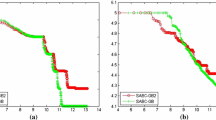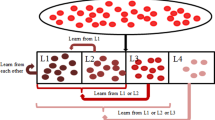Abstract
As known, the artificial bee colony (ABC) algorithm is an optimization algorithm based on the intelligent foraging behavior of honey bee swarm that has been proven its efficacy and successfully applied to a large number of practical problems. Aiming at the trade-off between convergence speed and precocity of ABC algorithm with elite-guided search equations (ABC_elite), an enhanced version, namely EABC_elite, is proposed in this paper, and the improvements are twofold. As the global best (gbest) solution is introduced to the search equation and acceleration of the convergence in the bee phase of EABC_elite, the former in the ordinary solution is embodied to the search equation yet balance the gbest’s ability. The enhancement to the global search by making the information of gbest and ordinary solutions be adequately used while keeping the exploration–exploitation balance well maintained, the usual solution is introduced to the search equation to avoid the precocity problem in the onlooker bee phase of EABC_elite as the latter one. Experimental analysis and evaluations of EABC_elite against several state-of-the-art variants of the ABC algorithm demonstrate that the EABC_elite is significantly better than the compared algorithms in the feature selection problem. Also, the proposed EABC_elite algorithm is modified to combine the K-means initialization strategy and chaotic parameters strategy to further enhance the global search of EABC_elite for data clustering. Experimental results show that the derived EABC_elite clustering algorithm “Two-step EABC_elite,” TEABC_elite for short, delivered better and promising results than previous works for data clustering.


Similar content being viewed by others
References
Goldberg DE, Holland JH (1988) Genetic algorithms and machine learning. Mach Learn 3(2):95–99
Storn R, Price K (1997) Differential evolution–a simple and efficient heuristic for global optimization over continuous spaces. J Glob Optim 11(4):341–359
Zhan Z, Zhang J, Li Y (2009) Adaptive particle swarm optimization. IEEE Trans Cybern 39(6):1362–1381
Dorigo M, Birattari M, Stutzle T (2006) Ant colony optimization. IEEE Comput Intell M 1(4):28–39
Karaboga D, Basturk B (2007) A powerful and efficient algorithm for numerical function optimization: artificial bee colony (ABC) algorithm. J Glob Optim 39(3):459–471
Karaboga D, Basturk B (2008) On the performance of artificial bee colony (ABC) algorithm. Appl Soft Comput 8(1):687–697
Du Z, Han D, Liu G, Bi K (2017) An improved artificial bee colony algorithm with elite-guided search equations. Comput Sci Inf Syst 14(3):751–767
Xiang W, Meng X, Li Y (2018) An improved artificial bee colony algorithm based on the gravity model. Inf Sci 429:49–71
Pan Q, Wang L, Li J (2014) A novel discrete artificial bee colony algorithm for the hybrid flowshop scheduling problem with makespan minimization. Omega 45:42–56
Bose D, Biswas S, Vasilakos AV (2014) Optimal filter design using an improved artificial bee colony algorithm. Inf Sci 281:443–461
Szeto W, Wu Y, Ho SC (2011) An artificial bee colony algorithm for the capacitated vehicle routing problem. Eur J Oper Res 215(1):126–135
Gao W, Chan F, Huang L (2015) Bare bones artificial bee colony algorithm with parameter adaptation and fitness-based neighborhood. Inf Sci 316:180–200
Zhu G, Kwong S (2010) Gbest-guided artificial bee colony algorithm for numerical function optimization. Appl Math Comput 217(7):3166–3173
Gao W, Liu S, Huang L (2013) A novel artificial bee colony algorithm based on modified search equation and orthogonal learning. IEEE Trans. Cybern. 43(3):1011–1024
Cui L, Li G, Lin Q (2016) A novel artificial bee colony algorithm with depth-first search framework and elite-guided search equation. Inf Sci 367(22):1012–1044
Kiran MS, Hakli H, Gunduz M (2015) Artificial bee colony algorithm with variable search strategy for continuous optimization. Inf Sci 300(8):140–157
Banharnsakun A, Achalakul T, Sirinaovakul B (2011) The best-so-far selection in artificial bee colony algorithm. Appl Soft Comput 11(2):2888–2901
Gao W, Liu S (2012) A modified artificial bee colony algorithm. Comput Oper Res 39(3):687–697
Karaboga D, Gorkemli B (2014) A quick artificial bee colony (qABC) algorithm and its performance on optimization problems. Appl Soft Comput 23(10):227–238
Gao W, Liu S, Huang L (2014) Enhancing artificial bee colony algorithm using more information-based search equations. Inf Sci 270(12):112–133
Gao W, Liu S (2011) Improved artificial bee colony algorithm for global optimization. Inf Sci 111(17):871–882
Cui L, Zhang K, Li G (2017) Modified Gbest-guided artificial bee colony algorithm with new probability model. Soft Comput 22(7):1–27
Kong D, Chang T, Dai W (2018) An improved artificial bee colony algorithm based on elite group guidance and combined breadth-depth search strategy. Inf Sci 442:54–71
Lin Q, Zhu M, Li G (2018) A novel artificial bee colony algorithm with local and global information interaction. Appl Soft Comput 62:702–705
Liang J, Qu B, Suganthan PN (2014) Problem definitions and evaluation criteria for the CEC 2015 competition on learning-based real-parameter single objective optimization. Computational Intelligence Laboratory, Zhengzhou University, Zhengzhou China, Tech. Rep. 201411A
Xiang W, Li Y, Mengl X (2017) A grey artificial bee colony algorithm. App Soft Comput 60(11):1–17
Li Y, Zhan Z (2015) Competitive and cooperative particle swarm optimization with information sharing mechanism for global optimization problems. Inf Sci 293(4):370–382
Cheng R, Jin Y (2015) A social learning particle swarm optimization algorithm for scalable optimization. Inf Sci 291(1):43–60
Li C, Yang S, Nguyen T (2012) A self-learning particle swarm optimizer for global optimization problems. IEEE Trans Man Cybern 42(33):627–646
Kiran MS, Hakli H, Gunduz M (2015) Artificial bee colony algorithm with variable search strategy for continuous optimization. Inf Sci 300(8):140–157
Gao W, Huang L, Wang J (2016) Enhanced artificial bee colony algorithm through differential evolution. Appl Soft Comput 48(11):137–150
Derrac J, Garcia S, Molina D (2011) A practical tutorial on the use of nonparametric statistical tests as a methodology for comparing evolutionary and swarm intelligence algorithms. Swarm Evol Comput 1(1):3–18
Tanweer MR, Suresh S, Sundararajan N (2015) Self regulating particle swarm optimization algorithm. Inf Sci 294(4):182–202
Zhang J, Sanderson AC (2009) JADE: adaptive differential evolution with optional external archive. IEEE Trans Evol Comput 13(5):945–948
Draa A, Bouzoubia S, Boukhalfa I (2015) A sinusoidal differential evolution algorithm for numerical optimization. Appl Soft Comput 27:99–126
Liang Z, Hu K, Zhu Q (2017) An enhanced artificial bee colony algorithm with adaptive differential operators. Appl Soft Comput 58(9):480–494
Chuang LY, Yang CH, Li JC (2014) Chaotic maps based on binary particle swarm optimization for feature selection. App Soft Comput 11(1):239–248
Ghamary M, Mobasheri MR, Mojaradi B (2014) Unsupervised feature selection using geometrical measures in prototype space for hyperspectral imagery. IEEE Trans Geosci Remote 52(7):3774–3787
Shi Y, Pun CM, Hu H (2016) An improved artificial bee colony and its application. Knowl Based Syst 107:14–31
Guo C, Zhou Y, Ping Y (2014) A distance sum-based hybrid method for intrusion detection. Appl Intell 40(1):178–188
Liu R, Chen Y, Jiao L (2014) A particle swarm optimization based simultaneous learning framework for clustering and classification. Pattern Recogn 47(6):2143–2152
Farnad B, Jafarian A, Baleanu D (2018) A new hybrid algorithm for continuous optimization problem. Appl Math Model 55(3):652–673
Karaboga D, Ozturk C (2011) A novel clustering approach: Artificial Bee Colony (ABC) algorithm. Appl Soft Comput 11(1):652–657
Boushaki SI, Kamel N, Bendjeghaba O (2017) A new quantum chaotic cuckoo search algorithm for data clustering. Expert Syst Appl 96(4):358–372
Xiang W, Zhu N, Ma S (2015) A dynamic shuffled differential evolution algorithm for data clustering. Neurocomputing 158(6):144–154
Yan X, Zhu Y, Zou W (2012) A new approach for data clustering using hybrid artificial bee colony algorithm. Neurocomputing 97(1):241–250
Gungor Z, Unler A (2007) K-harmonic means data clustering with simulated annealing heuristic. Appl Math Comput 184(2):199–209
Dang CT, Wu Z, Wang Z (2015) A novel hybrid data clustering algorithm based on artificial bee colony algorithm and k-means. Chin J Electron 24(4):694–702
Kumar Y, Sahoo G (2017) A Two-step artificial bee colony algorithm for clustering. Neural Comput Appl 28(3):537–551
Lu H, Zhang H, Ma H (2006) A new optimization algorithm based on chaos. J Zhejiang Univ-Sci A 7(4):539–542
Ebrahimzadeh R, Jampour M (2013) Chaotic genetic algorithm based on lorenz chaotic system for optimization problems. Int J Intell Syst 5(5):19–24
Alatas B (2010) Chaotic bee colony algorithms for global numerical optimization. Expert Syst Appl 37(8):5682–5687
May RM (1976) Simple mathematical models with very complicated dynamics. Nature 261(5560):459–467
Cui L, Li G, Wang X (2017) A ranking-based adaptive artificial bee colony algorithm for global numerical optimization. Inf Sci 417:169–185
Acknowledgements
Authors of this manuscript are grateful to the valuable comments provided by external reviewers and international experts for the improvement in technical and organization sections.
Funding
This research was supported in part by the National Natural Science Foundation of China (Nos. 61672338 and 61673160), in part by the Chaozhou Science and Technology Project (No. 2018GY45).
Author information
Authors and Affiliations
Corresponding author
Additional information
Publisher's Note
Springer Nature remains neutral with regard to jurisdictional claims in published maps and institutional affiliations.
Rights and permissions
About this article
Cite this article
Du, Z., Han, D. & Li, KC. Improving the performance of feature selection and data clustering with novel global search and elite-guided artificial bee colony algorithm. J Supercomput 75, 5189–5226 (2019). https://doi.org/10.1007/s11227-019-02786-w
Published:
Issue Date:
DOI: https://doi.org/10.1007/s11227-019-02786-w




